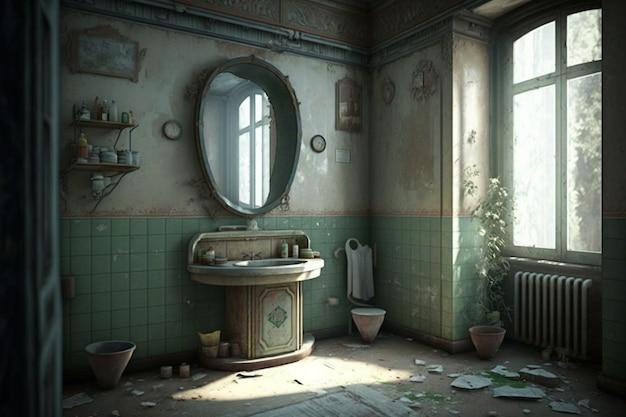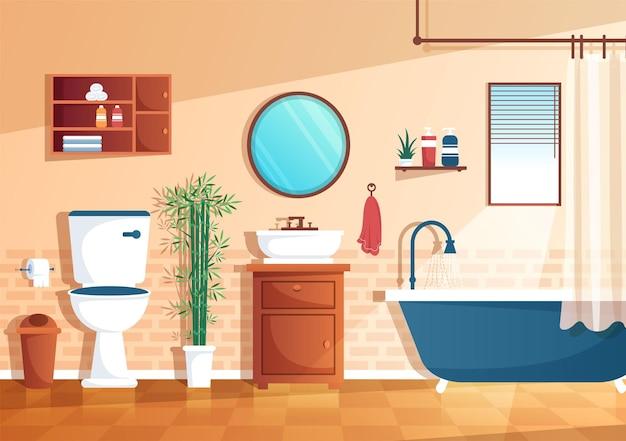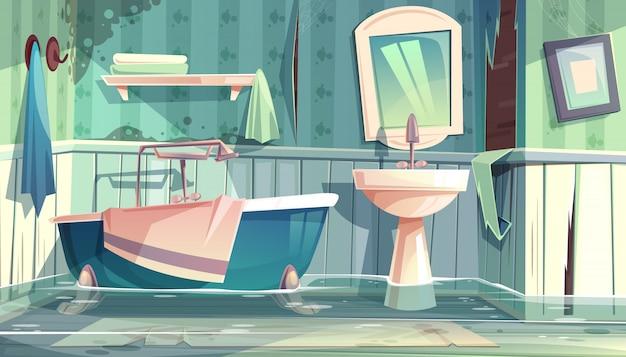There are few things more frustrating and stressful than discovering that your upstairs bathroom has flooded. Whether it’s due to a burst pipe, faulty toilet, or an overflowing bathtub, dealing with a flooded bathroom can be overwhelming. Not only do you have to worry about the immediate water damage, but there may also be long-term consequences, including mold and mildew growth, which can be hazardous to your health.
Perhaps you’re looking for advice on what to do if you flood your upstairs bathroom, or maybe you’re simply curious about the causes of bathroom flooding. Whatever the reason for your interest, we’ve got you covered with this comprehensive guide.
In this post, we’ll cover everything from the various causes of bathroom flooding to how you can deal with the immediate aftermath. We’ll discuss how to mitigate damage to your floors and ceilings, what to do if you’re dealing with a leaky ceiling, and how to handle water damage repairs.
So, if you’ve ever found yourself using the “flooded bathroom” excuse or have experienced a bathroom floor flooded after a shower, this post is for you. We’ll provide you with all the tools you need to deal with a flooded bathroom, so let’s get started!
What to Do When Your Upstairs Bathroom Floods
If you’re reading this article, it’s likely that you’re dealing with a flooded bathroom, and you’re looking for help. Don’t panic! There are several things you can do to mitigate the situation before calling a professional plumber. Here are some subsections to guide you through the process.
Shut off the Water Supply
The first and most crucial step to take is to cut off the water supply to the bathroom. Locate the main shutoff valve and turn it clockwise to stop the water flow. Doing this will prevent the flooding from escalating and causing more damage.
Turn off the Electricity
If the water has reached electrical outlets or submerged any electrical appliances, turn off the electricity at the main breaker box. Don’t attempt to touch any electrical appliance or the breaker box if you’re standing in water.
Remove the Water from the Floor
Get out any mop, bucket, or towel you can find to clean up the water immediately. The longer the water stays on the floor, the more likely it is to cause permanent damage. You can use a wet-dry vacuum machine or a pump to remove large pools of water on the floor.
Check for Leaks and Clogged Drains
The main cause of bathroom floods is leaking or clogged pipes. Check the pipes and joints underneath the sink, tub, and toilet for leaks or cracks. Also, look for any object or residue that may be clogging the drain. You can use a plunger or plumbing snake to clear away any blockage.
Call a Professional Plumber
If you have tried everything above, and the problem persists, it’s time to call a professional plumber. Trying to fix the problem yourself may lead to further damage, electrical shock or even injuries. Professional plumbers have the knowledge and expertise to fix the problem safely and efficiently.
In conclusion, a flooded bathroom can be a nightmare if not quickly addressed. By following the steps outlined above, you can minimize the damage, save on costs, and get back to your normal life sooner.
Dealing with the “Flooded Bathroom” Excuse
So, your upstairs bathroom has flooded, and you’re feeling justified in being late for work or canceling plans with friends. But don’t be too quick to make excuses! Here are some tips for turning a flooded bathroom into a manageable problem.
Take Responsibility
First things first: own up to any mess that has been made, whether it’s caused by a burst pipe, an overflowing toilet, or any other problem. The faster you take responsibility, the easier it will be to start dealing with the issue.
Limit the Damage
As soon as you notice the problem, turn off the main water supply to your home to prevent any further damage. You should also open windows and doors in the affected area to allow for better air circulation and let any excess water evaporate.
Call a Professional
Dealing with a flooded bathroom can be a daunting task, and it’s wise to call in the experts. A plumber or water damage restoration professional can assess the situation and offer solutions to fix the problem.
Clean Up the Mess
Once the water is under control, you’ll need to start cleaning up any remaining mess. This could involve removing damaged flooring or walls, disinfecting surfaces, and drying out any remaining water. Again, it’s often best to leave these tasks to the professionals.
Prevent Future Incidents
Finally, take steps to ensure that a flooded bathroom doesn’t happen again. This could mean regularly checking for leaks or investing in more robust plumbing systems. It’s also crucial to have a plan in place for dealing with any future emergencies quickly.
In conclusion, while a flooded bathroom may seem like a valid excuse for cancelling plans or being late for work, it’s essential to take responsibility and start dealing with the issue. Follow these tips, and you’ll be well on your way to getting everything back to normal.
Bathroom Flooding Causes
Bathroom flooding occurs due to a variety of reasons. Some of the common causes of bathroom flooding include:
1. Clogged Drain
A clogged drain is one of the primary culprits of bathroom flooding. When hair, soap scum, and other debris accumulate in the drain, water can’t flow smoothly to the pipes. As a result, water backs up and overflows onto your bathroom floor.
2. Broken Pipes
A broken or cracked pipe can cause a flood in your bathroom. Pipes can break due to age, wear and tear, or freezing. If you notice water stains on your ceiling, walls, or floors, it could be due to a broken pipe.
3. Overflowing Toilet
An overflowing toilet is another common reason why a bathroom floods. When too much toilet paper or other objects are flushed down the toilet, it could cause a blockage in the pipes. Water will then overflow from the toilet and onto your bathroom floor.
4. Faulty Plumbing
Faulty plumbing can cause bathroom flooding without warning. When the pipes in your bathroom are not installed correctly, fitted loose or compromised in any way, they can easily burst, causing significant damage.
5. Malfunctioning Appliances
Malfunctioning appliances like a washing machine or water heater can cause bathroom flooding. If these appliances are located upstairs, a leak can cause significant damage to the floors below.
In conclusion, understanding the causes of bathroom flooding can help you take preventative measures. Ensure that your bathroom appliances are working correctly, don’t flush anything down your toilet other than toilet paper, keep your drain free of debris, and have your plumbing system checked regularly to avoid any significant plumbing issues.
Dealing with a Flooded Bathroom
Has your upstairs bathroom flooded? That can be frustrating, especially if you don’t know what to do. You can quickly end up with a big mess and expensive repairs. However, don’t worry! In this article, we’ll show you what to do to minimize the damage from a flooded bathroom.
Turn off the Water Source
The first step to take when dealing with a flooded bathroom is to turn off the water supply. The water supply is typically located under the sink or toilet. Turn the knob clockwise until it is tight, and the water supply is closed.
Remove the Standing Water
Once you’ve turned off the water source, it’s time to remove any standing water in the bathroom. You can use a wet/dry vacuum or a mop to get rid of the water. Remove as much water as possible from the surrounding floor and walls.
Identify the Source of the Flood
After removing the water, you’ll need to determine the source of the flooding. The two most common sources of a flooded bathroom are a clogged drain or a broken pipe. Check the sinks, shower, and toilet drains to see if anything is blocking the water flow. If the blocked drain caused the flooding, you’ll need to remove the clog before you can use the bathroom again.
Call in the Professionals
If you can’t identify the source of the flood, or if you find a broken pipe, it’s time to call in the professionals. A plumber can help you fix the problem and prevent it from causing more damage.
Dry the Area
After you’ve identified the source of flooding and removed the water, you’ll need to dry the affected area thoroughly. You can use a fan or a dehumidifier to speed up the drying process. Be sure to check the corners and any hidden areas where water may have seeped. Damp areas can quickly lead to mold growth, which can be a health hazard.
Prevent Future Flooding
Once you’ve taken care of the immediate problem, you’ll need to take steps to prevent future flooding. Regularly check your plumbing system for leaks or clogs. Ensure that everyone in your household knows what to do in the event of a flooded bathroom.
In conclusion, if your upstairs bathroom has flooded, don’t panic. Turn off the water source, remove the standing water, identify the source of the flooding, call in the professionals if necessary, dry the area, and take steps to prevent future flooding. By following these steps, you can minimize the damage from a flooded bathroom and keep your home safe.
Bathroom Floor Flooded After Shower
Did you just finish a relaxing shower, only to find out that the bathroom floor is now flooded? Don’t panic. This is a common problem that many homeowners face, and there are several steps you can take to fix it.
Step 1: Turn off the Water Supply
The first thing you should do is turn off the water supply to the shower or bathtub. This will prevent any additional water from flowing and exacerbating the flood. You can usually find the shut-off valve under the sink or in the basement.
Step 2: Soak up the Water
Next, grab some towels or a mop and start soaking up as much of the water as possible. Try to get into all the cracks and crevices to ensure no water is left behind.
Step 3: Check for Leaks
Check for any leaks or cracks in the bathtub or shower that could have caused the flood. If you find any, repair them immediately to prevent any future floods.
Step 4: Allow Adequate Airflow
Make sure there is enough airflow in the bathroom to help dry out the area. Open windows and doors, turn on fans, or use a dehumidifier. This will help prevent mold and mildew from forming.
Step 5: Call a Professional
If you’re unable to fix the problem yourself or if the flood caused significant damage, it’s best to seek professional help. A plumber or water damage restoration specialist can thoroughly assess the situation and provide the necessary repairs.
In conclusion, a flooded bathroom floor after a shower can be stressful, but it’s possible to remedy the situation. Remember to turn off the water supply, soak up the water, check for leaks, allow adequate airflow, and call a professional if necessary. With these steps, you can fix the problem and prevent it from happening again in the future.
How to Deal with a Flooded Bathroom
Bathroom flooding can be a nightmare, but it’s essential to know what to do if it happens. Here are some easy steps to follow to deal with a flooded bathroom without losing your mind.
Turn Off the Water Supply
The first thing you need to do is turn off the main water supply to your home. This will help prevent further water damage and lower the amount of water in your bathroom. If you’re unable to do this yourself, you can call your plumber or the water company.
Turn Off the Power
Safety first! In the case of a flooded bathroom, turn off the electricity. It’s always best to ask your electrician to switch off the power supply to the area nearest the bathroom. This significantly reduces the risk of electrocution while cleaning up the excess water.
Remove the Water
You can start using a wet vacuum, buckets, and towels to remove the standing water. Begin by wiping down the surfaces in the bathroom to prevent any mold or mildew growth. Peeing water is not only hazardous to the user, but it’s also a source of unpleasant smell; that is why it’s essential to clean up as soon as possible.
Check for Water Damage
Check for water damage to walls, flooring, and cabinets. If water leaked beneath your flooring, remove it to dry the subfloors completely. Make sure you assess the damage to prevent any health hazards caused by hidden moulds or mildews.
Call a Professional
You may have done everything you could; however, if the damage is extensive, it’s always best to seek expert assistance. Call a professional water damage contractor who has the right equipment to extract water thoroughly and dry out water-damaged areas. They can also assist in addressing any structural damage or mould growth in your bathroom.
In conclusion, a flooded bathroom can bring you down in many ways, but it happens, and it’s best to be prepared. Always take preventive measures and familiarize yourself with steps to take in the case of a water emergency in your bathroom. Keep in mind that safety should come first, you can always call for expert help, and most importantly, don’t forget to stay calm.
How to Treat a Flooded Bathroom
Dealing with a flooded bathroom can be a nightmare, but don’t worry; there are ways to treat it. The following subsection will provide a step-by-step guide on how to treat a flooded bathroom.
Turn Off the Water Supply
The first step is to turn off the water supply. This prevents more water from coming into the bathroom and makes it easier to clean up. The water supply valve is typically located near the floor, behind the toilet or under the sink.
Remove Excess Water
The next step is to remove as much water as possible from the bathroom. Use a wet/dry vacuum to suck up the water or use towels to soak up the excess water. Make sure to use gloves and other protective gear while doing this.
Check for Water Damage
After removing all the excess water, examine the bathroom for any signs of water damage. Check the walls, ceiling, and flooring for any signs of cracks, discoloration, or soft spots. If you find any damage, take pictures and notify your insurance company as soon as possible.
Clean and Disinfect
The next step is to clean and disinfect the bathroom. Use a mixture of bleach and water to disinfect all the affected areas. Be sure to wear gloves and use protective eyewear. Scrub the floors, walls, and other surfaces with the mixture and let it sit for about 10-15 minutes before rinsing it off with clean water.
Dry the Bathroom
After cleaning and disinfecting the bathroom, it’s time to dry it out thoroughly. Use fans, dehumidifiers, and open windows to help speed up the drying process. Make sure to dry every corner of the bathroom to prevent mold growth.
In conclusion, treating a flooded bathroom can be a daunting task, but with the right steps, it can be done. Remember to turn off the water supply, remove excess water, check for water damage, clean and disinfect, and dry the bathroom thoroughly. If the damage is severe, do not hesitate to seek professional help.
What to Do if You Flood Upstairs Bathroom
When you realize your upstairs bathroom is flooding, the situation can be stressful and overwhelming. Here are some steps to take to mitigate the damage and prevent the issue from happening again:
Shut Off the Water Supply
The first thing you should do if your upstairs bathroom is flooding is to turn off the main water supply to your home. This will stop the flow of water and prevent further damage.
Check for Electrical Hazards
Water and electricity do not mix well and can be a dangerous combination. Before entering the flooded area, make sure to turn off the power supply to that area and avoid walking through any standing water if possible.
Locate the Source of the Problem
Next, you’ll want to identify the source of the flooding. Is it a burst pipe, a clogged drain, or an overflowing toilet? By identifying the source, you’ll be able to determine the best course of action to resolve the issue.
Call Your Insurance Company
In some cases, your homeowner’s insurance may cover the damage caused by a flood. Contact your insurance company as soon as possible to report the incident and start the claims process.
Clean Up the Water
Once you’ve addressed any potential hazards and mitigated further damage, it’s time to start cleaning up the water. Use a wet/dry vacuum, mop, or towels to dry up the area as much as possible.
Contact a Professional
Depending on the severity of the flood, it may be necessary to hire a professional to fully restore the area. A water damage restoration company can help eliminate any remaining moisture, repair any damage, and prevent mold growth.
Prevent Future Flooding
To avoid future flooding, make sure to properly maintain your plumbing and fixtures. Don’t flush anything down the toilet besides toilet paper, and avoid pouring grease or oil down the sink. Regularly inspect your pipes and fixtures for any signs of wear or damage.
By following these steps, you can navigate a stressful situation and minimize the damage caused by a flooded upstairs bathroom.
Upstairs Bathroom Flooded Leaking Through Ceiling
Imagine waking up to the sound of dripping water. Upon investigation, you realize that the upstairs bathroom has overflowed and is now leaking through the ceiling. What do you do now? Don’t panic; this issue is fixable. Below are steps to restore your house to its former glory.
Find the Source of the Leak
The very first thing you should do is shut off the water supply. Doing this will prevent further damage and give you time to find the source of the leak. Check all the pipes, faucets, and toilet for any signs of damage. Additionally, inspect the ceiling for signs of discoloration or water spots. Once you have identified the problem, you can proceed to fix it.
Fix the Problem
For minor leaks, use a silicone sealer or plumber’s tape to cover the area. If the problem is severe, it is best to call a professional plumber. However, if you are confident in your skills, go ahead and fix the problem yourself. Do not forget to turn on the water supply once the problem has been fixed.
Clean Up the Mess
After fixing the issue, it’s time to start cleaning up the water. Use towels or a mop to absorb as much water as possible. Also, open windows and switch on fans to facilitate quick drying and prevent mold growth.
assess the damage
Even after fixing the problem, water damage can cause further problems if not taken care of. It is best to assess the damage caused by the flood, including any damage to walls, flooring, or furniture. Consider hiring a professional restoration company to fix significant damage.
Dealing with an upstairs bathroom flooded leaking through the ceiling can be overwhelming. However, by following the steps outlined above, you can quickly solve the problem and prevent further damage to your home.



